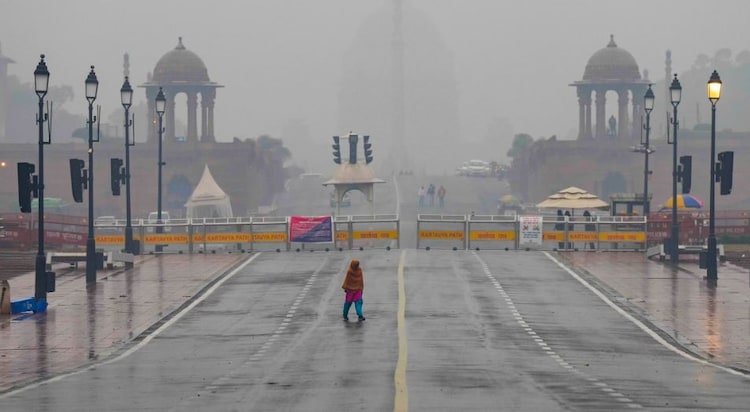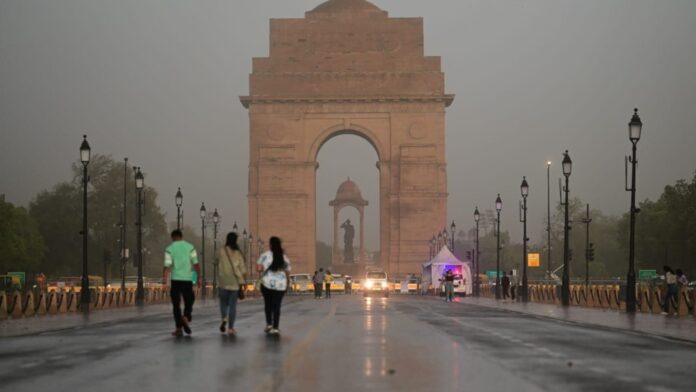In recent days, something unexpected happened in Delhi a sudden drop of 8 degrees Celsius brought relief from the blazing heat. Delhi is known for its extreme weather—sometimes the sun beats down so hot that the city feels like an oven, and other times, the air cools off unexpectedly. Recently, the city experienced a sudden drop in temperature from 40°C to 32°C. This change was not a slow transition but a quick drop that caught many people by surprise.
The Nature of Delhi’s Climate
Delhi has a climate that can be both very hot and sometimes very unpredictable. The city is no stranger to heatwaves, where temperatures soar high, making life difficult for its residents. The weather here can change quickly, which is partly due to the city’s unique geographical location and atmospheric conditions. Understanding the basics of Delhi’s climate helps us see why a sudden change like this can happen.
The sudden temperature drop of 8 degrees, from 40°C to 32°C, is unusual because it happened quickly due to a change in wind patterns and air pressure. This drop is significant enough to cause many questions about how such a dramatic change could occur.
The Unusual Temperature Drop
On a day when Delhi was burning at 40°C, the temperature suddenly fell to 32°C—a change of 8 degrees. This event was not a gradual cooling over several hours; it was a swift drop that affected the entire city almost at once. This cooling effect was felt by everyone, whether they were at home, at work, or out on the streets.
The Immediate Impact
For many, the sudden drop brought relief. People who had been struggling with the intense heat found it easier to step outside and go about their day. However, while the cooler temperature was welcome, it was also a reminder of how quickly weather patterns can change.
Why Is This Drop Important?
A sudden drop in temperature is not just a matter of feeling a bit cooler. It can impact:
- Health: Sudden changes in temperature can affect people’s health, particularly the elderly and those with chronic conditions.
- Daily Life: Work, travel, and other daily activities may need to adjust when the weather changes so abruptly.
- Energy Consumption: People may suddenly switch on fans or air conditioners less often, which can affect energy usage in the city.
The Science Behind the Change
To understand this sudden temperature drop, we need to look at the science behind weather. Weather is influenced by many factors including air pressure, wind speed, humidity, and geographical features. When these factors change, the weather can change very quickly.
Air Pressure and Its Impact

Air pressure is one of the key elements in weather. It is the weight of the air above us. When there is a difference in air pressure between two areas, air moves from the area of high pressure to the area of low pressure. This movement of air is what we feel as wind.
The Role of Wind in Changing Temperature
Wind can carry air from one region to another. If the wind brings cooler air into a hot area, the temperature can drop suddenly. This is exactly what happened in Delhi.
Air Pressure and Wind
Air pressure is like the invisible weight of the air pressing down on the Earth. It is influenced by the temperature and moisture in the air. When the temperature is high, the air is lighter, and when it is cooler, the air is heavier.
How Does Air Pressure Create Wind?
Wind is created by the movement of air from a region of high pressure to a region of low pressure. Imagine you have a balloon filled with air. If one side of the balloon is squeezed, the air moves towards the side with less pressure. This is similar to what happens in nature.
The 10-Gradient Difference
In the recent event in Delhi, there was a 10-gradient difference in air pressure between Amritsar in the west and Gorakhpur in the east. This difference is like a push that moves the air very quickly. The strong winds generated by this pressure difference traveled across Delhi, bringing with them cooler air that caused the temperature to drop by 8 degrees Celsius.
Amritsar: Located to the west of Delhi, Amritsar is known for its rich history and cultural heritage. In weather terms, it often experiences slightly different conditions compared to Delhi.
Gorakhpur: Situated to the east, Gorakhpur also has its own unique climate. The differences between these two cities play a role in how weather systems behave in the region.
The Pressure Difference
The 10-gradient difference in air pressure between these two cities created a scenario where air was forced to move from one area to the other. This movement was powerful enough to drive strong winds into Delhi. Such differences in pressure are not uncommon in India, where geographical and atmospheric conditions vary widely across regions.
How This Movement Affected Delhi
As the strong winds entered Delhi from these regions, they brought with them cooler air. This influx of cooler air pushed out the hot air that was lingering over the city, leading to the sudden drop in temperature. While the drop was significant, experts warn that it might be a temporary phenomenon, as the winds are expected to ease by Sunday, potentially leading to the return of a heatwave.
Is This a Sign of Sudden Climate Change?

The Debate on Climate Change
The conversation about climate change has been ongoing for many years. While a single weather event does not prove a trend, it does raise questions about whether our climate is becoming more unpredictable. Some experts believe that extreme weather events may become more common as global temperatures rise and the climate system becomes more volatile.
Linking the Dots
In the case of Delhi, the sudden drop in temperature might be seen as part of a larger pattern of unpredictable weather. A 10-gradient difference in air pressure causing such a dramatic change could be a sign that our atmosphere is reacting in new ways to global changes. Although it is too early to say definitively, the event has sparked discussions among scientists and weather experts about the potential impacts of climate change on daily weather patterns.
What Do the Numbers Say?
While it is important to note that one event does not define a long-term trend, scientists are closely monitoring the weather patterns in Delhi and other parts of the world. They use advanced models and historical data to predict future trends. A sudden drop in temperature can be one of many signals that indicate changes in our climate, urging us to pay attention and take action where necessary.
Public Perception and Climate Awareness
For many people, experiencing extreme weather firsthand can be a wake-up call. The sudden cool down in Delhi not only changed the temperature but also reminded people of the powerful forces of nature. This can lead to greater awareness about climate change and the need to protect our environment. When the weather surprises us, it encourages communities to discuss ways to adapt and prepare for future changes.
What Do Experts and Official Sources Say?
Insights from Meteorologists
Meteorologists have explained that the unusual temperature drop was primarily due to the air pressure difference between regions like Amritsar and Gorakhpur. These differences created strong winds that swept across Delhi, pushing out the hot air and replacing it with cooler air. They emphasize that while such events can be dramatic, they are a natural part of how our weather systems work.
Statements from Weather Agencies
Official weather agencies and government meteorological departments have noted the unusual event and provided detailed explanations. They have warned residents that while the cooling effect is welcome, it may only be temporary. The wind speeds are expected to decrease soon, which means that the heatwave could return. These agencies often recommend that people stay updated with the latest forecasts and prepare for rapid changes.
Research and Data
Researchers and climate scientists are constantly analyzing weather data to understand patterns. They look at temperature records, wind speeds, and air pressure changes over time. In the case of Delhi, the 8-degree drop provides valuable data that can help in refining weather prediction models. These models are essential for planning and for helping communities prepare for extreme weather events in the future.
Why Sudden Climate Change?
The sudden temperature drop in Delhi raises important questions. Is this a random event, or is it a signal of something bigger happening with our climate? Sudden weather changes force us to think about how nature works and how closely our lives are tied to the rhythms of the Earth. When the weather shifts so quickly, it reminds us that we are part of a larger system that is constantly changing.
The Role of Human Activity
One of the most debated topics is whether human activity contributes to these sudden changes. While the direct cause of the 8-degree drop in Delhi was a natural pressure gradient, there is a broader discussion on how human-induced climate change might be making such events more common. Increased pollution, deforestation, and urbanization can all influence local weather patterns. Though this event is a clear case of natural atmospheric changes, it is hard to ignore the global conversation on how we treat our environment.
How to Prepare for More Sudden Changes?
-1733713948887_v.webp)
One of the best ways to handle sudden weather changes is to have effective early warning systems. Technology has advanced significantly, allowing meteorologists to predict changes with greater accuracy. When authorities issue timely alerts, residents have a better chance to adapt—whether it’s by dressing appropriately, adjusting travel plans, or simply staying informed.
Local governments can make a big difference in how communities respond to extreme weather. Measures such as installing more weather stations, improving public communication channels, and organizing community awareness programs can help everyone be more prepared. When communities work together, the impact of sudden weather changes can be minimized.
Educating the public about weather patterns and climate change is vital. Simple workshops, community meetings, and school programs can help everyone understand what is happening and why. Knowledge is power, and being informed is the first step toward effective action in the face of sudden weather events.
Final Thoughts
The sudden 8-degree drop in Delhi’s temperature is a double-edged sword. On one side, it brings immediate relief to a city that had been suffering under a brutal heatwave. On the other, it is a reminder of how unpredictable nature can be. While we welcome the cooler air, we must remain vigilant and prepared for the return of the heat. This event serves as a powerful lesson that weather can change in an instant, and that both individuals and authorities need to be ready for these shifts.
Ultimately, managing sudden weather changes is a collective responsibility. It involves everyone—from government officials and scientists to local communities and individuals. By staying informed, being proactive, and taking steps to protect our environment, we can better navigate the challenges of an ever-changing climate.
While the cool respite brought by the sudden drop in temperature was a welcome change for many, it also serves as a reminder that nature is full of surprises. As we move forward, let us take this event as an opportunity to deepen our understanding of weather patterns, to question how we are influencing our climate, and to work together to build a more resilient future for Delhi and beyond.

